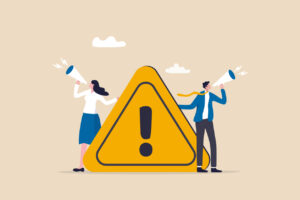In modern reputation management, brand journalism is an essential tool
How to help establish your story and brand position in today’s media landscape—a crucial preventative measure for brands to avoid crises and fight misinformation.

As a crisis communications advisor, Mindy Hamlin is often called in once the fire has started. Someone has taken to social media, or is threatening public action that could jeopardize how an organization is perceived in the community.
Real money is on the line, and many organizations say they now place reputation and trust at the center of major business decisions—even before considerations of profit and revenue. In a report from Signal AI, over 85% of business leaders and decision makers say that reputation is a higher priority than margin when making decisions.
Yet, if preventative measures aren’t taken, crisis mitigation efforts can be too little, too late.
Hamlin, principal with Hamlin Communications, shared an example of one client on a recent call for Ragan’s Crisis Leadership Network, who had visibility in small communities they served where leaders were faced with a reputational threat when a disgruntled former employee accused them of failing to support women and people of color in the organization. When Hamlin talked to leaders, however, “they start telling me all these fantastic stories.”
Hamlin was floored by the ways that the organization had helped employees and there were diverse leaders and women who held meaningful positions—but the company hadn’t told their story sufficiently, and they were vulnerable.
“I go and start searching on their website and their social media channels and [the stories] are not there,” Hamlin said. “All I did find were lots of announcements about white men being promoted…”
Like so many organizations, Hamlin’s client didn’t have storytelling efforts set up in advance and so when a crisis hit, they couldn’t tell the story they needed to share. That’s why it is essential for organizations to grow that “champions list,” Hamlin said.
While the client ended up settling out of court with the former employee, Hamlin made a clear point that storytelling efforts should be started immediately to bolster the organization’s reputation across channels. In this instance, the cost of not doing so had a very real price tag in the court room.
Content strategy and reputation
What is the content mix that will protect your brand’s reputation? Hamlin argues that you don’t need to gin up a brand new, bespoke content strategy. Instead, weave stories about your organization into the content you already have planned.
There’s no reason you can’t have a leader take your audience behind the scenes or do an employee profile as part of your ongoing content efforts, Hamlin said. She offered five important stories that brands should tell:
- Community involvement. “LinkedIn is a good audience but don’t neglect Facebook and Twitter,” Hamlin said.
- Employee profiles. This is an opportunity to share the values your organization has and operates on, Hamlin said. However, don’t rely on CEO statements to make your point. Follow the time-honored communications dictum: “Show; don’t tell.”
- Preparedness. “A lot of my work is in airports,” Hamlin gave as an example. “If a snowstorm were coming, we go out and interview the maintenance crews that would be clearing the runways… We were educating people on what we do and how we do it.” She said that Heathrow Airport in London does a wonderful job creating content about the safety measures it takes to prevent “birdstrikes” (when airplane hits a bird, causing engine failure, a la the “Miracle on the Hudson.”)
- Safety procedures. Again, this is content that can be shared to answer consumer/audience questions about safety. Hamlin said this content can be blog posts or videos featuring leaders.
- Leadership. “I caution against having a leader in front of a white wall talking and talking and talking,” she said. “But if you have a leader who has a great personality who is engaging and who cares, it’s a great opportunity to show them talking to employees, talking to customers, etc.” The late Arne Sorenson, who, as CEO for Marriot, showed great empathy for workers during COVID-19, is a good example.
Where to share your story
Once you have created content that elucidates your internal culture and brand values, how do you get it in front of consumers? In a fractured media environment, owned media and social media sharing are essential.
Hamlin recommended sharing on these channels:
- Blog or website. This can be your home base where you can send visitors form other channels.
- Social media to share your resources. Make sure to link back to your website.
- Video and podcasts.
- E-newsletters. The caveat is this only works if your audience is really engaged, Hamlin added.
Hamlin said that this is when the value of brand journalism can really be seen. “Pittsburg International Airport has created a newsletter that reads like an industry newspaper,” she gave as an example. As part of its coverage, the CEO is speaking to Pete Buttigieg, U.S. secretary of transportation, about infrastructure, as well as telling stories about its latest activities and efforts.
Action steps
For communicators looking to start right away on building their brand story and bolstering their reputation, Hamlin offered five action items:
- Make telling your brand’s story a priority.
- Share your values.
- Shine the spotlight on your employees.
- Invite your customers and community behind the scenes.
- Share authentic moments with your leaders.
Get more insights on how to prepare for crisis situations and build your organization’s reputation by joining Ragan’s Crisis Leadership Network.







